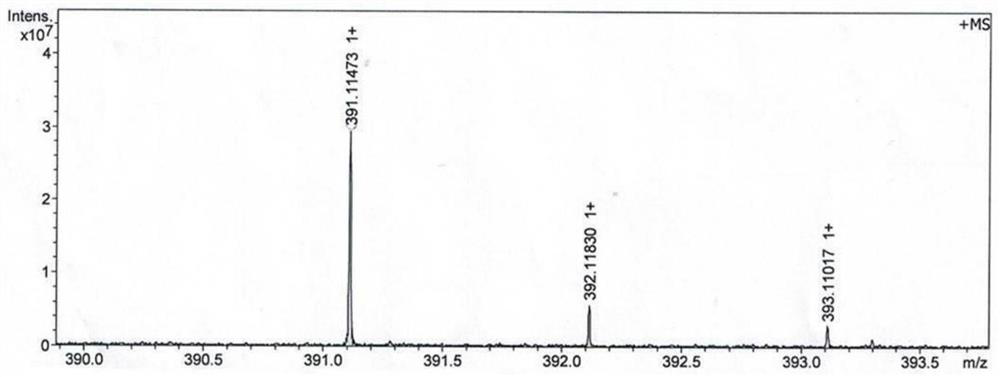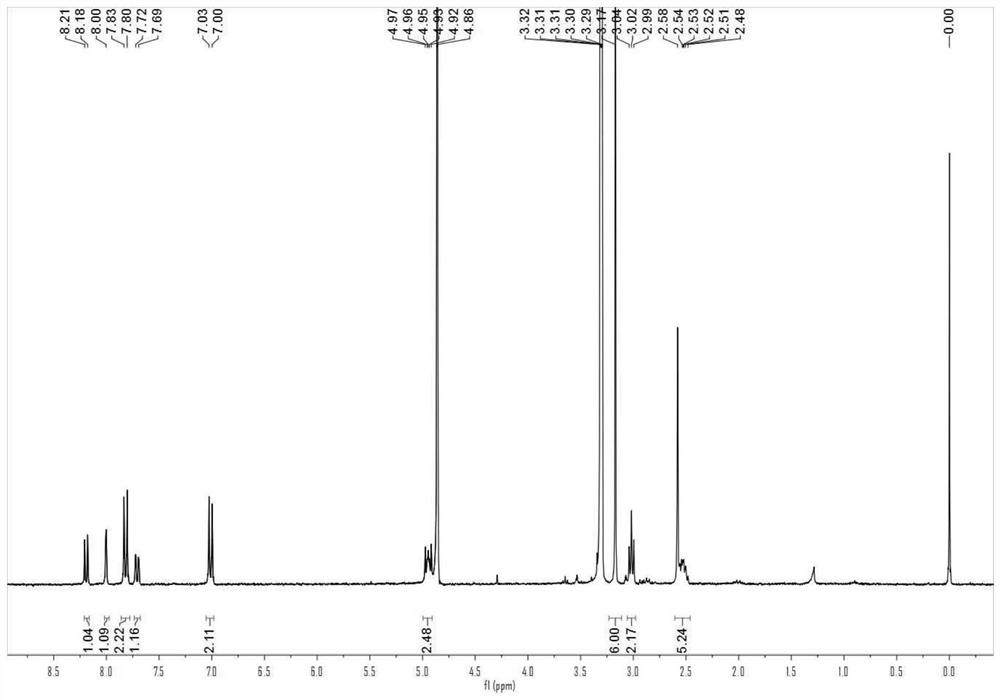Fluorescent probe and method for detecting DNA G-quadruplex in living cell mitochondria
A technology of cell and fluorescence imaging, which is applied in the field of analytical chemistry and biochemistry, can solve the problems of lacking and inability to deeply reveal the physiological function and mechanism of mitochondrial G-quadruplex, and achieve low cytotoxicity, good anti-photobleaching performance, The effect of high sensitivity
- Summary
- Abstract
- Description
- Claims
- Application Information
AI Technical Summary
Problems solved by technology
Method used
Image
Examples
Embodiment 1
[0055] The synthesis methods of compounds (1) to (4) are shown below. In addition, the inventor has confirmed that the structure of the above-mentioned compound is correct by analyzing the hydrogen spectrum, carbon spectrum and / or mass spectrum data of the compound, wherein, the mass spectrum and NMR of compound (1) are as follows figure 1 , figure 2 Shown; Compound (2) mass spectrometry and NMR are respectively as image 3 , Figure 4 shown.
[0056] The synthesis method of compound (1): 2-amino-5-methylthiophenol and 4-dimethylaminobenzaldehyde are mixed and then added to 180-200°C under the catalysis of paraformaldehyde to react, and the obtained compound T1, T1 was mixed with [1,2]oxythiol 2,2-dioxin at a ratio of 1:3, then added to 155°C, and reacted for 12 hours to obtain compound (1) with a total yield of 6.3%. The spectrum analysis of the proton nuclear magnetic spectrum and mass spectrum of compound (1): 1H NMR (400MHz, CD 4 O)δ8.20(d,1H),8.00(s,1H),7.80-7.83(d,...
Embodiment 2
[0065] Utilize the compound (1) of the embodiment of the present invention to carry out cytotoxicity experiment, specifically as follows
[0066]
[0067] (1) Dissolving compound (1) with a small amount of dimethyl sulfoxide;
[0068] (2) The cultured HeLa and MCF-7 cells were added different concentrations of compound (1) solutions and continued to culture for 72 hours;
[0069] (3) Add 10% MTT solution after sucking up the culture medium, and continue culturing for 4 hours;
[0070] (4) After the culture medium was blotted dry, DMSO was added to dissolve it, and the absorbance at 490 nm was measured with a microplate reader. Count the number of viable cells. Take the concentration of the probe (1) as the abscissa, and take the cell viability as the ordinate to draw a graph. The result is as Figure 5 , Figure 6 As shown, the survival rate exceeds 70%, which shows that THT-S has relatively low cytotoxicity and has the necessary conditions as a living cell probe.
Embodiment 3
[0072] The compounds (1)-(4) and MitoLite Red probes of the embodiments of the present invention were used to perform fluorescence imaging on the cells, as follows:
[0073]
[0074](1) live cell culture, cervical cancer (Hela) cells and human breast cancer cells (MCF-7) in DMEM medium containing 10% fetal bovine serum (FBS) and 1% 100U / mL double antibody, in 5% CO 2 , Cultivate at 37°C for 48h.
[0075] ⑵Use a small amount of dimethyl sulfoxide to dissolve compounds ⑴~⑷ and MitoLite Red probe respectively;
[0076] (3) Add the solutions of the compounds (1) to (4) and the MitoLite Red probe in step (2) respectively to the culture medium, and prepare the culture solution containing the compounds (1) to (4) at a concentration of 20 μM and the culture solution of MitoLite Red at a concentration of 1.0 μM, respectively;
[0077] (4) Use a pipette gun to pipette 1mL of the culture solution of compounds (1) to (4), add them to the culture dishes of Hela and MCF-7 cells, and put...
PUM
 Login to View More
Login to View More Abstract
Description
Claims
Application Information
 Login to View More
Login to View More - R&D
- Intellectual Property
- Life Sciences
- Materials
- Tech Scout
- Unparalleled Data Quality
- Higher Quality Content
- 60% Fewer Hallucinations
Browse by: Latest US Patents, China's latest patents, Technical Efficacy Thesaurus, Application Domain, Technology Topic, Popular Technical Reports.
© 2025 PatSnap. All rights reserved.Legal|Privacy policy|Modern Slavery Act Transparency Statement|Sitemap|About US| Contact US: help@patsnap.com



